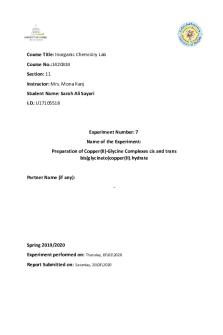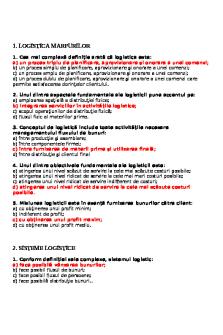Cu II Glycine complex PDF

| Title | Cu II Glycine complex |
|---|---|
| Author | Bizarre Gaming |
| Course | biophysical chemistry |
| Institution | Merrimack College |
| Pages | 6 |
| File Size | 251.9 KB |
| File Type | |
| Total Downloads | 18 |
| Total Views | 172 |
Summary
Cu II Glycine complex...
Description
Course Title: Inorganic Chemistry Lab Course No.:1420333 Section: 11 Instructor: Mrs. Mona Kanj Student Name: Sarah Ali Sayari I.D.:U17105518
Experiment Number: 7 Name of the Experiment: Preparation of Copper(II)-Glycine Complexes cis and trans bis(glycinato)copper(II).hydrate
Partner Name (if any): -
Spring 2019/2020 Experiment performed on: Thursday, 19\02\2020 Report Submitted on:
Saturday, 21\03\2020
O BJECTIVE : The analysis of the compounds to verify which complex is the kinetic product and which one is the thermodynamic product. The preparation of both copper glycine complexes—cis and Trans.
INTRODUCTION: Glycine is a member of a biologically important group of compounds called amino acids. Amino acids consist of at least one amino group (NH2) and a carboxylic acid group (-COOH). They are the basic structural units of proteins and therefore constitute the building blocks of living cells. Proteins are polypeptides or polyamides formed by the repeated linking of the -NH2 group of one amino acid to the -COOH group of another. Glycine contains two atoms capable of donating a pair of electrons (the N of the amine group and an O of the carboxylic acid group) and can simultaneously form two bonds with copper (II) cation. It therefore functions as a chelating ligand (from the Greek word chele for claw) and results in the formation of Cu(gly)2. This compound exists in two isomeric forms: the cis isomer (like donor atoms on the same side of the copper) and the Trans isomer (like donor atoms on opposite sides.
The four-coordinate, square planar geometry is most commonly associated with d8 electron configurations. The square planar complexes of d9 metal ions such as copper(II) are unusual but not unknown. One such compound is cis(glycinato)copper(II), in which the deprotonated form of the amino acid glycine is a bidentate ligand. For square planar complexes that contain two equivalents of the bidentate glycinato ligand (NH2CH2COO–), there are two different possible geometric arrangements, cis and trans. Because these two isomers have different point group symmetries, they should be distinguishable on the basis of their vibrational spectra.
In this experiment, the cis and trans copper glycinates are prepared. The direct reaction of copper(II) acetate monohydrate and glycine results in an equilibrium mixture of the two isomers. [(CH3CO2)2Cu.H2O]2 + H2NCH2CO2H → cis-Cu(gly)2.H2O + trans-Cu(gly)2.
One isomer precipitates much more quickly than the other, leading to a shift in the equilibrium away from the other, producing only the one isomer. The first isomer (kinetically favored product) is converted to the other (thermodynamically favored product) simply by heating.
MATERIALS: o o o o o o o o o o o
Analytical balance Beaker Graduated cylinder Thermometer Glass watch suction filtration Büchner funnel Spatula stirrer Hot plate Bottle (for saving the product).
CHEMICALS: o o o o
copper(II)acetate monohydrate distilled water ethanol glycine
o ice
PROCEDURE: (All of the experiment must be done under the hood)
A. CIS CU(GLY)2.H2O: 123456-
Dissolve 2.0 g of copper(II) acetate monohydrate in hot distilled water. Under the Hood, add 25 mL of hot ethanol to the solution then keep the solution hot. Dissolve 1.5 g of glycine in 25 mL hot water. Mix the two hot solutions while hot (~70oC). Cool the solution to room temperature then in ice bath for 15 minutes. Collect the precipitate using the Büchner filtration system. Wash with small amount of cold water then ethanol. Continue filtering for several minutes to draw air through the funnel to help air dry the precipitate. (Kinetically cis is the favoured product, cis is stable in aqueous solution). 7- The product can be recrystallized using hot water. 8- Weigh the product and determine the yield. 9- Save the product in a labelled and stoppered test tube.
B. TRANS CU(GLY)2.H2O 1- Weigh about 0.5 g of cis-product then heat in an oven at 170oC for an hour. 2- Cool in air, this converts the cis-product into the thermodynamically more stable anhydrous trans-product. (Thermodynamically trans is the favoured product in gas and solid- phase).
DATA AND RESULTS: Mass of Cupper II Acetate monohydrate= 2.0116 ± 0.0001 g MM of Cupper II Acetate monohydrate= 199.65 g/mol Number of moles of Cupper II Acetate monohydrate: n=
mass 2.0116 g =0.010 076 mol = MM 199.65 g/mol
Mass of Cu(gly)2H2O = 1.6093 ± 0.0001 g MM of Cu(gly)2H2O = 229.67 g/mol Number of moles of Cu(gly)2H2O: n=
mass 1.6093 g =0.0070091 mol = MM 229.67 g /mol nactual
× 100 The percentage yield= n theoretical ¿
0.0070091 × 100=69.5 % 0.010076
DISCUSSION& CONCLUSION: In conclusion, we have successfully achieved the objectives of this experiment and learned how to prepare the both copper glycine complexes—cis and Trans. Cis and trans bis(glycinato)copper(II).hydrate complexes were prepared and the percentage yield was 54.80% which wasn’t quite high, but there were errors which effected the % yield, such as: Losing some of the product during the mixing Not controlling the temperature Instrumental errors.
REFERENCES: https://webs.wofford.edu/hilljb/Chem%20323/CopperGlycine.pdf lab manual PowerPoint from Ms. Mona Kanj...
Similar Free PDFs

Cu II Glycine complex
- 6 Pages

Cu SO
- 7 Pages

Proef 109 (Cu SO4
- 18 Pages

Ingrijirea Pacientei Cu Cezariana
- 75 Pages

CU Registrar Instrumentos
- 5 Pages

Grile cu variante Logistica
- 16 Pages

Penentuan kadar CU
- 19 Pages

Complex Arguments 6
- 5 Pages

2020. Complex Numbers. Rangitoto
- 10 Pages

19600 Complex Checklist 1
- 8 Pages

Complex Numbers summary
- 16 Pages

Titration of Glycine with Na OH
- 3 Pages
Popular Institutions
- Tinajero National High School - Annex
- Politeknik Caltex Riau
- Yokohama City University
- SGT University
- University of Al-Qadisiyah
- Divine Word College of Vigan
- Techniek College Rotterdam
- Universidade de Santiago
- Universiti Teknologi MARA Cawangan Johor Kampus Pasir Gudang
- Poltekkes Kemenkes Yogyakarta
- Baguio City National High School
- Colegio san marcos
- preparatoria uno
- Centro de Bachillerato Tecnológico Industrial y de Servicios No. 107
- Dalian Maritime University
- Quang Trung Secondary School
- Colegio Tecnológico en Informática
- Corporación Regional de Educación Superior
- Grupo CEDVA
- Dar Al Uloom University
- Centro de Estudios Preuniversitarios de la Universidad Nacional de Ingeniería
- 上智大学
- Aakash International School, Nuna Majara
- San Felipe Neri Catholic School
- Kang Chiao International School - New Taipei City
- Misamis Occidental National High School
- Institución Educativa Escuela Normal Juan Ladrilleros
- Kolehiyo ng Pantukan
- Batanes State College
- Instituto Continental
- Sekolah Menengah Kejuruan Kesehatan Kaltara (Tarakan)
- Colegio de La Inmaculada Concepcion - Cebu



